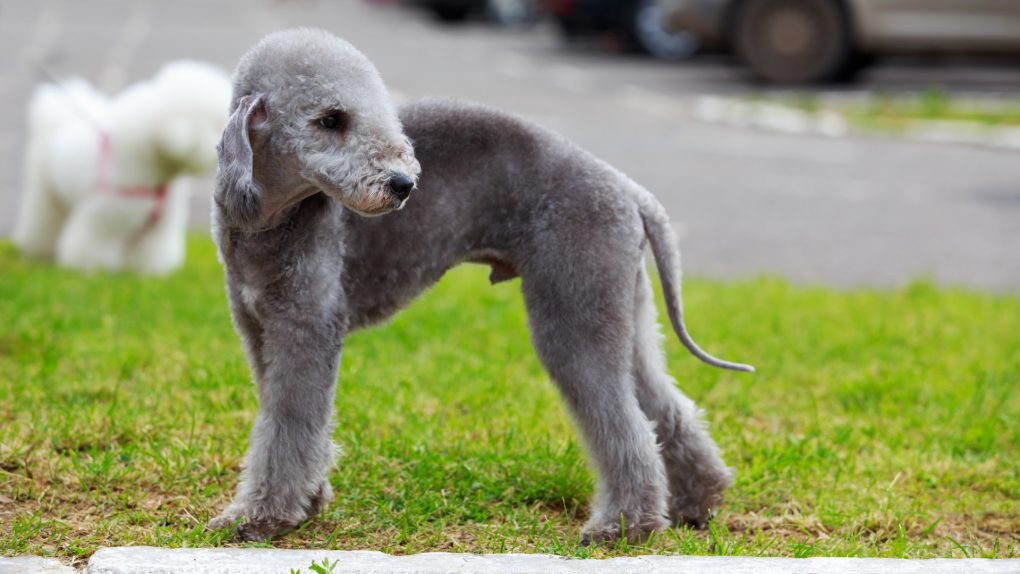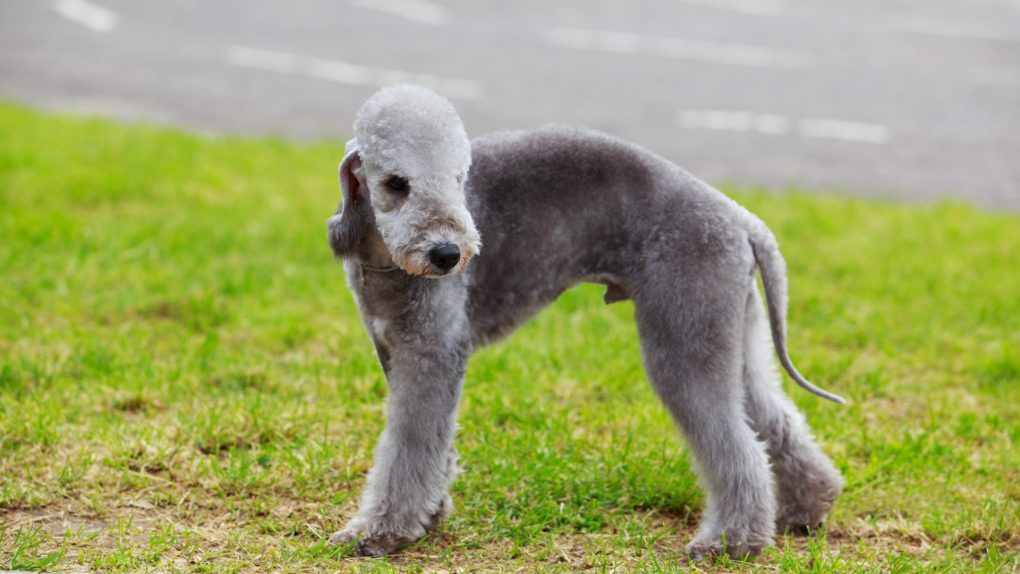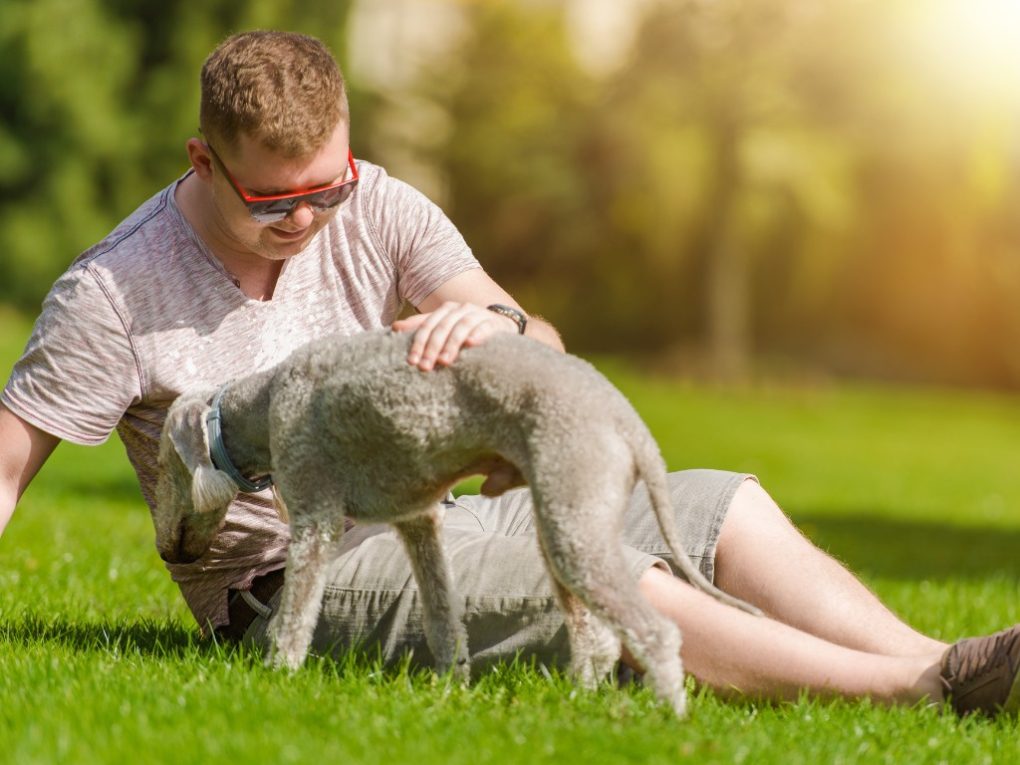Blue Bedlington Terrier: A Unique and Elegant Breed
Blue Bedlington Terrier is a small dog known for its unique appearance and charming personality. The breed is named after the mining town of Bedlington in Northumberland, England, where it was originally bred to hunt vermin. The Blue Bedlington Terrier is a loyal and affectionate companion adaptable to various living environments.


The Blue Bedlington Terrier is a small-sized dog that typically weighs 17-23 pounds and stands 15-17.5 inches tall. Its most distinguishing feature is its curly, woolly coat, typically blue. The breed’s coat is hypoallergenic, making it an excellent choice for people with allergies. To keep Blue Bedlington Terriers healthy and happy, it’s important to provide them with regular exercise and mental stimulation. These active dogs are easy to train using positive reinforcement techniques.
Blue Bedlington Terriers are known for their sweet and affectionate personalities. They are loyal and devoted to their families and make excellent companion dogs, and are also good with children and other pets, making them a popular choice for families. Blue Bedlington Terriers are fearless and protective of their loved ones despite their small size, making them excellent watchdogs.
Table of Contents
History
The Blue Bedlington Terrier has a rich history that dates back to the early 19th century. The breed originated in the mining town of Bedlington, located in Northumberland, England, and was bred to hunt vermin, such as rats and rabbits, as well as larger game like foxes and badgers.
The Blue Bedlington Terrier was originally known as the Rothbury Terrier, after the nearby town of Rothbury. However, the breed was later renamed after the town of Bedlington, where it was most commonly found. Joseph Ainsley, a breeder from Bedlington, is credited with developing the breed as we know it today.
Ainsley’s Piper, born in 1825, is considered the first dog to be called a Bedlington Terrier. Piper was a skilled hunter, known for his ability to take down the most ferocious of otters. He started hunting at just eight months old and continued for many years.
The Blue Bedlington Terrier was also a popular breed among miners in Northumberland. They were used to hunt vermin in the mines and for sport outside of work. The breed’s agility and speed made it an ideal choice for hunting, and its loyal and affectionate nature made it a beloved companion.
Today, the Blue Bedlington Terrier is still a popular breed for those looking for a loyal and affectionate companion. Its unique appearance, with its lamb-like head and lion-like heart, continues to capture the hearts of many dog lovers worldwide.
Appearance
The Blue Bedlington Terrier is a small, unique-looking dog breed known for its distinctive appearance. The breed’s coat is one of its most defining features, with a thick, curly coat that gives it a lamb-like appearance. The coat can come in various colors: blue, sandy, liver, and tan.
Blue Bedlington Terriers have a solid-colored coat that can be blue, black, sandy, or liver-colored. The coat is soft and curly, standing away from the skin. The breed’s coat is also hypoallergenic, making it a great choice for those with allergies.
The Blue Bedlington Terrier’s head is pear-shaped, and they have a graceful, arched back. The breed’s ears are long and tasseled, and the tail is scimitar-shaped. The overall effect is a dog that looks like a fluffy lamb.


It is worth noting that Blue Bedlington Terriers can be prone to copper toxicosis, a genetic condition that affects the liver’s ability to process copper. Symptoms of copper toxicosis can include lethargy, vomiting, and jaundice. Regular blood tests can help detect the condition early.
The Blue Bedlington Terrier is a small, unique-looking dog breed with a thick, curly coat and a lamb-like appearance. The breed’s coat can come in various colors: blue, sandy, liver, and tan. The breed’s head is pear-shaped, and they have a graceful, arched back. However, they can be prone to copper toxicosis, affecting their liver’s ability to process copper.
Temperament
The Blue Bedlington Terrier is known for its loyal, protective, and affectionate nature. They are intelligent and spirited dogs that make great companions for those who are willing to put in the time and effort to train and socialize them properly.
Despite their small size, Blue Bedlington Terriers make excellent watchdogs. They are quiet and alert, always keeping an eye out for any potential danger. Their protective nature makes them great at keeping their family safe.
While they are protective, they are not aggressive. Blue Bedlington Terriers are known for their calm and gentle nature, and are great with children and other pets, making them an ideal family dog.
These dogs are highly intelligent and require mental stimulation to prevent boredom. They are quick learners and respond well to positive reinforcement training methods.
The Blue Bedlington Terrier is a loyal and affectionate companion that makes an excellent watchdog. They are intelligent and spirited dogs that require proper training and socialization. Their protective nature keeps their family safe, while their calm and gentle nature makes them great with children and other pets.
Health
The Blue Bedlington Terrier is generally a healthy breed, with a lifespan of 11 to 16 years. However, like all breeds, they are prone to certain health issues affecting their quality of life. Here are some of the common health problems that Blue Bedlington Terriers may face:
Eye Problems
Blue Bedlington Terriers can have eye problems such as distichiasis and retinal dysplasia. Distichiasis is a condition where extra eyelashes grow on the eyelid, which can cause irritation and discomfort. Retinal dysplasia is a genetic condition that affects the development of the retina, which can lead to vision problems.
Copper Storage Disease
One of the most serious health issues that Blue Bedlington Terriers can face is copper storage disease. This is a genetic condition where copper accumulates in the liver, leading to liver damage and failure. Symptoms of copper storage disease include vomiting, diarrhea, and jaundice. If your Blue Bedlington Terrier is diagnosed with copper storage disease, they will need lifelong treatment to manage the condition.
Other Health Issues
In addition to the above conditions, Blue Bedlington Terriers may also be prone to hip and elbow dysplasia, hypothyroidism, and von Willebrand’s disease. Responsible breeders will screen their breeding stock for these conditions to reduce the risk of passing them on to offspring.
To ensure that your Blue Bedlington Terrier stays healthy, it’s important to provide them with regular veterinary care, a healthy diet, and plenty of exercise. In addition, regular check-ups can help catch any health issues early on, while a balanced diet and exercise can help maintain their overall health and wellbeing.
Grooming
Grooming a Blue Bedlington Terrier is a crucial aspect of owning one. Their unique coat requires regular attention to keep it healthy and looking its best. Here are some tips for grooming your Blue Bedlington Terrier:
- Brushing: Regular brushing your Blue Bedlington Terrier’s coat is essential to prevent matting and tangling. Use a slicker brush or comb to remove dead hair and keep the coat smooth and shiny.
- Trimming: Trimming your Blue Bedlington Terrier’s coat is essential to maintain its shape and prevent matting. Use scissors or clippers to trim the hair on the head, ears, legs, and tail.
- Bathing: Bathing your Blue Bedlington Terrier is necessary to keep its coat clean and healthy, use a mild dog shampoo and rinse thoroughly to avoid any skin irritation.
- Non-shedding: Blue Bedlington Terriers are non-shedding dogs, requiring regular grooming to prevent their hair from becoming matted and tangled.
Grooming your Blue Bedlington Terrier is an essential part of their care routine. Regularly brushing, trimming, and bathing your dog can keep their coat healthy and looking its best.
Training and Exercise
Training and exercise are essential for the physical and mental well-being of a Blue Bedlington Terrier. This breed is known for its energy and requires daily exercise and mental stimulation to stay healthy and happy.
Obedience Training
Obedience training is crucial for any dog, and Bedlington Terriers are no exception. These dogs are intelligent and eager to please, making them relatively easy to train. Positive reinforcement techniques, such as treats and praise, work well with this breed. Consistency is key, and Bedlington Terriers respond well to a structured routine.
Agility
Bedlington Terriers excel in agility and are known for their speed and agility. Agility training can provide an excellent outlet for their energy and help keep them mentally stimulated. This activity can also help improve their obedience skills, coordination, and overall fitness.
Exercise
Bedlington Terriers require at least an hour of exercise each day. Regular exercise can help prevent obesity, leading to various health problems. Walking, running, and playing are all great ways to provide exercise for your Bedlington Terrier. They also enjoy playing fetch and other mental and physical stimulation games.
Walking
Daily walks are essential for a Bedlington Terrier’s physical and mental well-being. Walking provides an opportunity for exercise, socialization, and mental stimulation. It also helps prevent boredom, which can lead to destructive behavior.
Therapy Dogs
Bedlington Terriers can make excellent therapy dogs due to their calm and gentle nature. They are affectionate and enjoy spending time with people. Therapy dogs can emotionally support individuals in hospitals, nursing homes, and other settings.
Performance
Bedlington Terriers can participate in various performance activities, including obedience trials, agility competitions, and flyball. These activities can provide an excellent outlet for their energy and can help improve their obedience skills.
Training and exercise are essential for the physical and mental well-being of a Blue Bedlington Terrier. Obedience training, agility, exercise, walking, therapy dogs, and performance activities are all great ways to provide mental and physical stimulation for this breed.
Breed Standards and Breeding
Blue Bedlington Terriers are a unique breed with specific standards that breeders must adhere to when breeding. The breed standard is a set of guidelines that describe the ideal dog of a particular breed, and it serves as a benchmark for judges at dog shows. The Bedlington Terrier breed standard is maintained by the Bedlington Terrier Club of America, recognized by the American Kennel Club (AKC).
The Bedlington Terrier is a member of the Terrier breed group known for its energetic and aggressive nature. The Bedlington Terrier is a small to medium-sized terrier known for its curly, woolly coat and distinctive pear-shaped head. The breed originated in the United Kingdom and was used to hunt vermin and foxes.
When breeding Bedlington Terriers, breeders must follow the breed standard to ensure that the dogs they produce meet the ideal specifications. The breed standard specifies the desired height, weight, and physical attributes of the dog, as well as its temperament and behavior. Breeders must also consider the dogs’ health, as certain genetic conditions are more prevalent in Bedlington Terriers, such as copper toxicosis.
To maintain the breed’s genetic diversity, breeders must carefully select their dogs and avoid inbreeding. The Bedlington Terrier is closely related to several other terrier breeds, including the Dandie Dinmont Terrier, Kerry Blue Terrier, and Rothbury Terrier. Breeders must also consider AKC registration statistics when breeding, as the breed’s popularity can affect its genetic diversity.
Breeding Blue Bedlington Terriers requires adherence to the breed standard, careful selection of breeding pairs, and consideration of genetic diversity and health. By following these guidelines, breeders can produce healthy, well-adjusted dogs that meet the ideal specifications of the breed.
Rescue and Adoption
Blue Bedlington Terriers are a popular breed often sought after by those looking to adopt a furry friend. However, before purchasing a puppy, it is important to consider adoption options. Adopting a dog not only helps provide a loving home to a dog in need, but it also helps reduce the number of dogs in shelters.


Several Bedlington Terrier rescue programs specialize in rescuing and rehoming Bedlington Terriers. These programs rely on donations for support and often have a network of foster homes where the dogs can stay until they are adopted. When adopting a dog from a rescue program, an adoption fee and donation are often requested to help with various expenses the dog may have incurred while in the care of Bedlington Rescue.
For those looking to adopt a Blue Bedlington Terrier, a great place to start would be by contacting a Bedlington Terrier rescue program. These rescue programs often have a waiting list of dogs that need a loving home. Adopting an adult dog from a rescue program can also be a great option for those who cannot commit to the time and effort required to train a puppy.
It is important to note that while adopting a dog can be a rewarding experience, it is also a big responsibility. Before adopting a Blue Bedlington Terrier, potential adopters should consider their lifestyle and ensure they have the time, space, and resources to provide a loving home to a dog.
Adopting a Blue Bedlington Terrier from a rescue program can be a great option for those looking to provide a loving home to a needy dog. These rescue programs rely on donations for support and often have a network of foster homes where the dogs can stay until they are adopted. Before adopting a dog, potential adopters should consider their lifestyle and ensure that they have the time, space, and resources to provide a loving home to a dog.
